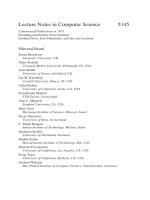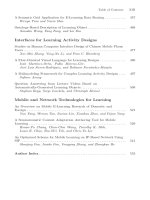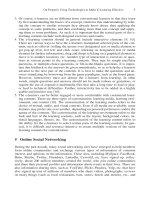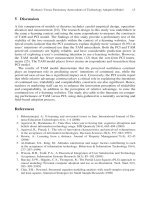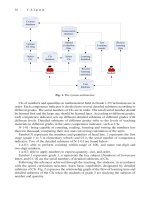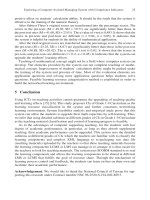Lecture Notes in Computer Science- P79 pps
Bạn đang xem bản rút gọn của tài liệu. Xem và tải ngay bản đầy đủ của tài liệu tại đây (153.08 KB, 5 trang )
A Sociogram Analysis on Group Interaction in an Online Discussion Forum 379
Fig. 1. The interface of group discussion forum
2.4 Data Collection
Data in this research were collected from group discussion forum in WebCL. The
postings in the discussion forum included two sessions produced by students when
they were working for the group task one and two. The data also included two catego-
ries based on group task accordingly. When a posting was analysed, it needed to be
identified who posted it, its purpose, and communication target. The results were used
for a sociogram analysis.
3 Data Analysis
3.1 Interaction within Group One
Group interaction within group one of the group task one is presented in Figure 2.
Fig. 2. The interactions within the group one for the first group task
The total number of messages posted for the group task one was 29 and the average
number of postings was 5.8. Mr. Zxl107 posted 12 messages to other 2 persons and the
centre of the group. Miss Zhenzhen posted 10 messages to other 2 persons and the centre
Centre
Zxl107
Dongweidan
Zhenzhen
Einstein
Missuxp
7.0
5.0
1.0
4.0
3.0
1.0
2.0
1.0
1.0
1.0
1.0
2.0
380 J. Zhao
of the group. Mr. Einstein posted 5 messages to other 3 persons and the centre of the
group. Mr. Dongweidan posted 1 message to the centre of the group. Mr. Missuxp posted
only 1 message to the centre of the group.
The number of messages to the group centre was 14 (48.3%). The result reveals
that almost the half messages were posted to the group task. It means that the half of
the interaction was taken place among group centre and participants, rather than
among participants.
Einstein was the best active student in group one because he communicated with
other 3 persons. Zhenzhen and Zxl107 were the second active students because they
interacted with other 2 students. Dongweidan was the third active student. During the
interaction process, he communicated with other 1 student. Missuxp was the weakest
active student and no other students communicated with him. Figure 2 demonstrates
that 93.1% messages were sent by 3 most active students posting. Other 2 students
only contributed their group 6.9%.
Group interaction for the group task two in group one is described in Figure 3.
Fig. 3. The interactions within the group one for the second group task
Total number of the messages posted by students for the group task two was 32
and average number of postings was 6.4. This number was a little bit bigger than the
number of the messages for the first group task. Mr. Zxl107 posted 12 messages for
the second group task. Miss Zhezhen posted 8 messages to the group. Mr. Einstein
contributed 6 messages to the group work. Mr. Missuxp posted 4 messages to the
group. Mr. Dongweidan posted 2 messages to group.
The number of messages to the group centre was 19 (59.4%). It demonstrates that
more than half messages were posted to the group task, rather than for interaction
among different participants.
Miss Zhenzhen and Mr. Einstein were the best active students because they inter-
acted with other 4 students. Mr. Missuxp was the second active student because he
Centre
Zxl107
Dongweidan
Zhenzhen
Einstein
Missux
p
9.0
6.0
2.0
1.0
1.0
1.0
1.0
2.0
2.0
1.0
1.0
1.0
1.0
1.0
2.0
A Sociogram Analysis on Group Interaction in an Online Discussion Forum 381
communicated with other 3 students. Mr. Zxl107 and Mr. Dongweidan were the third
active students who interacted with other 2 students.
The number of messages for the group task two was increased (29 vs. 32), which
reveals that group interaction was more active. The number of messages posted by 3
students for the group task two (Mr. Zxl107, Miss Zhenzhe, and Mr. Einstein) was
reduced (81.25% vs. 18.75%), and it demonstrates that the interaction was much more
average. The number of the messages to the group centre for the group task two was
increased (48.3% vs. 59.4%), which illustrates that the interaction among students
was less active.
3.2 Interaction within Group Two
The interaction within group two for the group task one is described in Figure 4.
Fig. 4. The interaction within group two for the first group task
The total number of the messages posted by students for the group task one was 25
and the average number of the postings was 5. Mr. Xiuyulin posted 8 messages
(32%), Miss Pearl posted 7 messages (28%), Mr. Fragrad contributed 5 messages
(20%), and Mr. Kingston posted 4 messages (16%). According to their postings, these
four students were most active. Mr. Felix was less active because he only posted 1
message to the group and receives 1 message from Mr. Fragrad. 2 students posted
messages were less than the average number.
The number of messages to the group centre was 13 (52%). It demonstrates that
less than half messages were for the interaction among participants.
Mr. Fragrad interacted with other 3 students and he was the most active student in
the group. Miss Peral, Mr. Xiuyulin, and Mr. Kingston were the second active stu-
dents. Each of them interacted with the other 2 students. Mr. Felix was the weakest
active student in the group and only 1 student interacted with him.
The interaction within group two for the group task two is presented in Figure 5.
The total number of the messages posted by students for the group task two was 42
and the average number of the messages was 8.4. Miss Pearl posted 11 messages
(26.2%). Mr. Xiuyulin posted 10 messages (23.8%). Mr. Fragrad posted 9 messages
Centre
Pearl
Xiuyulin
Fragrad
Kingston
Felix
3.0
2.0
2.0
3.0
1.0
5.0
2.0
1.0
3.0
1.0
1.0
1.0
382 J. Zhao
(21.4%). The number of messages was posted by Mr. Kingston was just less than the
average number (8). These four students posted the most messages (90.1%) for the
group task. Comparing with the number of the messages in the group task one, it was
more average in the second group task.
The number of messages to the group centre was 17 (40.5%), which means more
than half messages were used for communicating between or among participants. This
number indicates that students were more active for the group task two.
Fig. 5. The interaction within group two for the second task
Miss Pearl and Mr. Kingston were the most active students within the group, be-
cause they interacted with other 4 students. However, Miss Pearl posted 7 messages
for interacting with other students. Mr. Kingston just posted 5 messages. Therefore,
Miss Pearl was the best active student. Mr. Kinston was the second most active stu-
dent in the group. Mr. Xiuyulin and Mr. Fragrad were the third most active students.
Mr. Felix was the less active student in the group.
The increased number of messages for the group task two (25 vs. 42) illustrates that
the interaction was much more active. The reduced number of messages to the group
centre for the group task two (52% vs. 40.5%) reveals that the interaction between or
among students was much more active. The reduced number of messages posted by
three most active students (Mr. Fragrad, Miss Pearl, and Xiuyulin) for the second group
task (80% vs. 71.4%) demonstrates that the interaction was more average.
3.3 Interaction within Group Three
The interaction within group three for the group task one is described in Figure 6.
Only 3 students were within this group. The total number of the messages for the
first group task was 15 and the average number of the messages was 5. Mr. Byronspm
posted 6 messages (40%), Miss Gigi posted 5 messages (33.3%), and Miss Tina
posted 4 messages (26.7%). The messages were posted by them were average. Ac-
cording to the number of their postings, Mr. Byronspm was most active student.
Centre
Fragrad
Xiuyulin
Kingston
Felix
3.0
4.0
2.0
4.0
1.0
1.0
2.0
5.0
2.0
3.0
2.0
3.0
1.0
1.0
1.0
1.0
1.0
2.0
2.0
Pearl
1.0
A Sociogram Analysis on Group Interaction in an Online Discussion Forum 383
Fig. 6. The interaction in group three for the first group task
The number of messages to the group centre was 10 (66.7%), which means that
most messages were posted for the group task, rather than for the communication
between or among participants.
The interaction within group three for the group task two is presented in Figure 7.
Fig. 7. The interaction in group three for the second group task
The total number of postings for the second task was 21 and the average number of
the messages was 7. Miss Gigi posted 9 messages (42.9%), Mr. Byronspm posted 7
messages (33.3%), and Miss Tina posted 6 messages (28.6%). According to their
postings, Miss Gigi was most active student.
The number of the messages to the group centre was 11 (52.4%), which means
more than half messages were posted for the group task, rather than for the communi-
cation between or among participants.
The increased number of the messages for the group task two (15 vs. 21) demon-
strates that the interaction for the group task two was more active. The reduced num-
ber of the messages to the group centre (66.7% vs. 52.4%) reveals that the interaction
between or among students was more active.
3.4 Interaction within Group Four
The interaction within group four for the group task one is presented in Figure 8.
Centre
Byronspm
Tina
Gigi
3.0
4.0
4.0
1.0
1.0
2.0
3.0
2.0
2.0
Centre
B
y
rons
pm
Tina
Gigi
5.0
2.0
3.0
1.0
1.0
1.0
2.0
